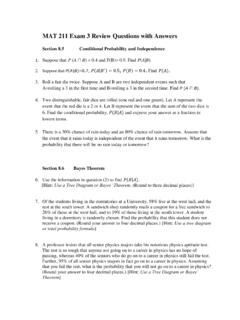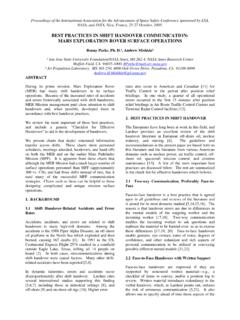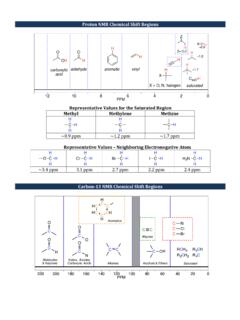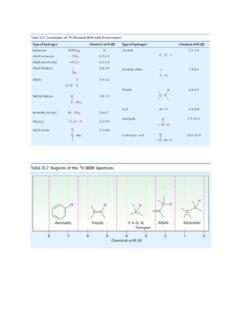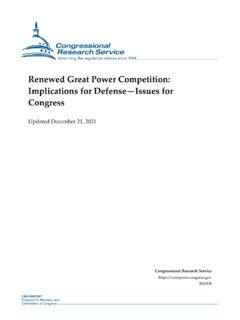Transcription of Shift (Caesar) Ciphers - Arizona State University
1 Shift (Caesar) CiphersIf you have a message you want to transmit securely, you can encrypt it (translate it into a secretcode). One of the simplest ways to do this is with ashift cipher. Famously, Julius Caesar used thistype of cipher when sending messages to his military Shift cipher involves replacing each letter in the message by a letter that is some fixed numberof positions further along in the alphabet. We ll call this number theencryption key. It is just thelength of the Shift we are using. For example, upon encrypting the message cookie using a shiftcipher with encryption key 3, we obtain the encoded message (orciphertext): make all of this more mathematical, consider the following conversion table for the Englishalphabet:0 1 2 3 4 5 6 7 8 9 10 11 12A B C D E F G H I J K L M13 14 15 16 17 18 19 20 21 22 23 24 25N O P Q R S T U V W X Y the table, we can represent the letters in our message cookie with their correspondingnumbers: 2 14 14 10 8 add 3 (the encryption key) to each number to get: 5 17 17 13 11 use the table to replace these numbers with their corresponding letters.
2 Is a small complication when we want to encrypt a message that contains a letter near theend of the alphabet. For example, if we consider the new message pizza, then what letter shouldwe use to replace the z when we encrypt?After performing a Shift cipher encryption with encryption key 3, the message pizza becomesSLCCD. The letter z was replaced with the letter C, which we can view as being 3 placesfurther along than z if, after we reach z, we cycle the alphabet around to the beginning terms of the numerical representations of our letters, the encryption of the message pizza looksthis way:15 8 25 25 0 18 11 2 2 have we done mathematically? There is a handy mathematical concept that describes thisvery nicely.
3 Define the following notation for integersaandband integerm >1:a b(modm) meansmis a divisor ofa our situation, we take the numberm(themodulus), to be equal to the size of our character set, som= 26. Now take each numberxfrom the representation of the message and perform the followingarithmetic: add 3 tox, and if the result is between 0 and 25, stop; otherwise, replacex+ 3 with theintegerybetween 0 and 25 that satisfiesy x+ 3 (mod 26).In summary, our encryption of the message pizza using a Shift cipher with encryption key 3 lookslike this:p 15 15 + 3 18 (mod 26) Si 8 8 + 3 11 (mod 26) Lz 25 25 + 3 2 (mod 26) Cz 25 25 + 3 2 (mod 26) Ca 0 0 + 3 3 (mod 26) DHow is the original (plaintext) message recovered from the ciphertext if the encryption key is known?
4 The following ciphertext was produced using a Shift cipher with encryption key 9: decrypt it ( , to recover the plaintext message), we need to add 17 (..or subtract 9..why is that the same?) to each of the numbers representing the ciphertext letters. Here 17 is thedecryption keyfor the Shift cipher with encryption key 9. Again, we must sometimes replace theresult of this addition with the appropriate number between 0 and 25:L 11 11 + 17 2 (mod 26) cQ 16 16 + 17 7 (mod 26) hX 23 23 + 17 14 (mod 26) oL 11 11 + 17 2 (mod 26) cX 23 23 + 17 14 (mod 26) oU 20 20 + 17 11 (mod 26) lJ 9 9 + 17 0 (mod 26) aC 2 2 + 17 19 (mod 26) tN 13 13 + 17 4 (mod 26) eLet s think about security now.
5 Suppose you intercept a transmission of an encrypted message, andyou know that the sender has used a Shift cipher on the English alphabet, but you do not know theencryption key. How difficult would it be for you to break the code?If we exclude the encryption key 0, there are only 25 distinct shifts that might have been used. Itprobably wouldn t take very long (especially with computer help) to test each of these shifts in turn(anexhaustive search). An incorrect Shift length is likely to produce gibberish, while the correctshift length will produce a sensible message. Note however, that spaces between words, punctuation,etc., will not be included in the plaintext that is recovered. For example, the message fish n chips would appear as fishnchips in its plaintext you find the plaintext that produced the ciphertext below?
6 A Shift cipher with undisclosedencryption key was you answered the above question by performing an exhaustive search. However, if themessage had been longer, possibly you could have taken a shortcut. Suppose you have a somewhatlengthy passage of ciphertext that you want to decrypt, but you do not have the key. If you knowthat a Shift cipher was used on a plaintext message written in standard English, then you can employfrequency analysis: determine which letter occurs most often in the ciphertext. It is very likely thatthis letter represents the plaintext letter e. Assuming that it does, the decryption key can now becalculated. Then try decrypting the entire message using this probable are good that the above procedure will find the correct plaintext on the first try.
7 If it doesn t, , if the outcome is gibberish, then find the next most likely representative of the plaintext letter e and try again. Below is ciphertext produced by a Shift cipher with undisclosed encryption it using frequency analysis. (Note that the line breaks do not necessarily occur betweenwords!)WIVHLVETPRERCPJZJTRESVLJVU FEFKYVIKPGVJFWTZGYVIJKFFSLKZKZJEFKLJLRCC PRJJZDGCVRJZKZJNZKYJYZWKTZGYVIJDREPFWKYV JVFKYVITZGYVIJNZCCRGGVRIYVIVZEKYVEVOKWVN DFEKYJ


